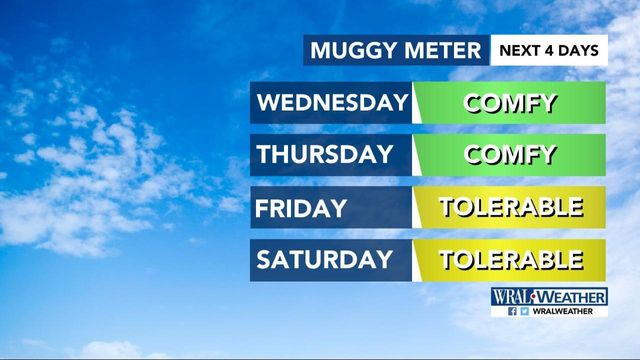Thunderstorms gone, feeling like September in July next few days
After a brief tornado warning Tuesday afternoon, the immediate threat had cleared before the evening rush hour, leaving only the chance for thunderstorms and steady rain. A cold front marching through the region packs the possibility of torrential downpours, lightning and gusty winds.
Posted — UpdatedAfter a brief tornado warning Tuesday afternoon, the immediate threat cleared before the evening rush hour, leaving only the chance for thunderstorms and steady rain. A cold front marching through the region packs the possibility of torrential downpours, lightning and gusty winds.
With the thunderstorms now gone, we'll be enjoying lower-than-normal temperatures at least for the next couple of days. Meteorologist Mike Maze said our normal low in July is 70 but it'll be around 63 through Friday.
"So the next three mornings, it will feel like early September," Maze said. "It's still the same for afternoon highs. Our normal high is 90 and we're expecting 84 (Wednesday), 85 on Thursday and 86 on Friday, all with partly to mostly sunny skies. Again, these numbers are more indicative of the start of September.
"For those of you who work outside, the weather the next few days is for you. You've suffered enough."
Right after 3 p.m., the National Weather Service issued the tornado warning that included parts of Johnston County, but no official tornado reports were recorded and no damage was reported. As the front made its way from northwest to southeast, temperatures dropped precipitously.
Power was out at several locations in Raleigh and the Triangle but was scheduled to be fully restored by 2 a.m. Wednesday. In Holly Springs, winds brought a tree down on some power lines along N.C. Highway 55, knocking out power.
Milder days follow cold front
Skies will clear after midnight, Maze said. The cold front will usher in a series of cooler, partly cloudy days, bringing relief from a recent stretch of days with a heat index over 100 degrees. Wednesday through the weekend will see high temperatures in the mid- to upper-80s with some clouds each day but little chance of precipitation.
Temperatures climb gradually from Tuesday's 80-degree high back into the low 90s by Monday.
=====
Motorists warned about dangers of heavy rain, high winds forecast during evening rush hour
The North Carolina Department of Transportation issued a warning for drivers about the risks related to flood-covered roads.
"If you do have to travel, drive defensively, slow down and leave extra space between your vehicle and those in front of you," Marty Homan, NCDOT spokesman said. "Never drive through standing or rushing water. Six inches of water will reach the bottom of most cars, causing possible loss of control and stalling. It takes just a foot of water to carry away many vehicles, while two feet of rushing water can carry many pickups and SUVs off a road into possible floodwater. Most flood-related drownings occur when someone drives through standing or rushing water and their vehicle is swept away."
He offered these additional tips for safe driving in bad weather:
- If your car starts to hydroplane, take your foot off the gas, apply the brakes in a steady, slightly firm manner and steer in the direction of the skid. If you have a manual transmission, push in the clutch and let the car slow down on its own;
- For vehicles with anti-lock brakes, apply more steady pressure to the brakes, but avoid pumping them;
- If the rain is extremely heavy, pull over in a safe area, either in a parking lot or on the roadside, with your emergency flashers on. Park far from any trees or other tall objects and wait for the weather to improve;
- If line markings on the road are not visible, do not take a chance. Turn around. It is possible the road was washed away and the water may be much deeper than you expect;
- Do not drive into standing water that can hide hazards, including debris and fallen trees or powerlines;
- Allow more travel time by reducing your speed by at least five to 10 miles per hour;
- Allow at least twice the normal following distance;
- Signal for turns ahead of time and brake early as you near a stop. Roads are the most slippery in the first 10 to 15 minutes of rainfall;
- Pay attention to advisories and directions from law enforcement, and to any signs;
- Heavy rainfall often saturates the ground beneath trees with shallow root systems. Be especially careful when driving around a curve as a tree could be down on the roadway and you don’t have time to stop;
- If you must drive, be sure your tires and brakes are in good working condition;
- Be patient and do not pass lines of traffic;
- Turn on your headlights, as required by North Carolina law, while using your windshield wipers – regardless of the time of day; and
- If a traffic signal is knocked out by a storm, regard the intersection as a four-way stop. If two or more vehicles arrive at the same time, the car to the right has the right of way and after signaling, may move in any direction. If two facing vehicles approach the intersection at the same time, any car traveling straight ahead or turning right has the right of way.
Related Topics
• Credits
Copyright 2024 by Capitol Broadcasting Company. All rights reserved. This material may not be published, broadcast, rewritten or redistributed.






